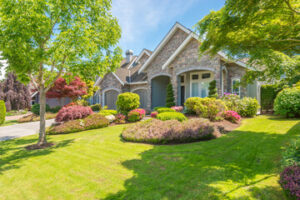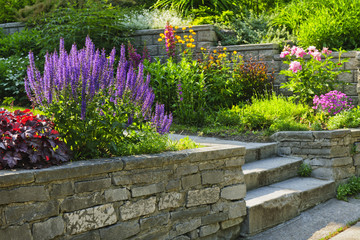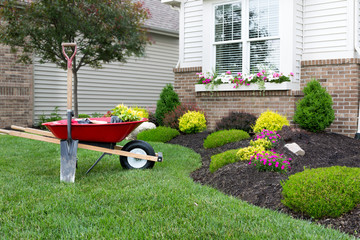A well-designed landscape can reduce water and energy costs. For example, choosing low-water plants and using mulch can help conserve moisture in the soil. Planting trees that go dormant in the summer or implementing the xeriscaping approach can also be helpful.
Prioritizing unity in your design can make the entire landscape feel like it belongs together, even if there is some variety. Using similar building materials for pathways and patios can cultivate this sense of unity. Contact Greensboro Landscaping for professional help.
The design of landscape features involves a number of different elements. These include color, texture, line, form and balance. These are crucial to creating a visually appealing and cohesive outdoor space. They can also enhance a property’s value and create a relaxing atmosphere for family and friends. There are many different types of landscaping, including softscapes like trees, shrubs and flowering plants, as well as hardscape features, such as pavers, flagstone walkways, custom concrete work, outdoor kitchens and fire pits. The design of these features depends on the type of space and its intended use. For example, a residential garden is designed to appeal to the homeowner and their guests, while campus landscape projects are designed to attract students, alumni and donors.
Texture is an important aspect of landscape design, and it adds depth to the overall visual appeal. It is often achieved by combining different textures of the same element. For example, pairing smooth, flowing grasses with rough stone paving can create an intriguing contrast. It can also be achieved by incorporating different forms of the same element, such as round, square or cylindrical shapes. For example, curved walkways can lend a more welcoming, cozy feeling to the landscape while straight lines can convey formality and provide clear separation between outdoor spaces.
Another important aspect of landscape design is flow, which is created by incorporating a sense of progression. This can be done in a variety of ways, including the use of contrasting colors, forms or textures. It is also important to consider the transition between the different parts of a landscape, such as how a walkway should flow into a lawn or garden.
Rhythm is an important principle in landscape design and refers to the repetition of certain elements, such as color, shape or size. Rhythm is also used in the arrangement of different components of a landscape to create a rhythmic effect. For example, a row of trees can be used to create a rhythmic pattern that leads the eye through the landscape.
Keeping your landscape design simple is essential to achieving harmony and balance. Overcomplicating your landscape can cause it to look cluttered and busy, and it can also disrupt the rhythm and balance of the space. However, simplicity doesn’t mean boring or bland. A well-designed landscape should still be unique and creative, but it should avoid being too flamboyant or chaotic.
Outdoor features construction
A well-planned and designed landscape can make a property feel like a home, while adding value and providing an inviting place to relax and gather. In order to accomplish this, landscape construction uses a variety of elements to create both aesthetic and functional outdoor spaces. These include softscapes and hardscapes, plant materials, lighting, and structures such as gazebos and pergolas.
Softscapes refer to living horticultural elements that are part of a landscape design, such as trees, shrubs, flowers, and lawns. These elements add color, texture, and seasonal interest to the space. They also provide shade, wind protection, and energy savings. Additionally, they can help improve air quality and provide habitat for wildlife.
Hardscape features are non-living, man-made components of a landscape that are constructed from materials such as pavers, flagstone walkways, and custom concrete work. These features are important to the overall landscape because they add function and structure to the space. They can also be used to define boundaries and create a sense of visual appeal.
Water features are another popular addition to landscape designs. These include fountains, ponds, and waterfalls, which can add a calming and serene feel to the space. In addition to enhancing the visual appeal of a yard, they can also add a soothing sound and promote water conservation.
Lighting is another essential component of landscape construction. It helps to illuminate the space and highlight its features, such as plants and trees, and can make it more enjoyable for both people and animals. Lighting can also be used to increase the safety and security of an outdoor space.
The use of fire features is an increasingly popular trend in landscape construction. Fire pits and fireplaces are a great way to add warmth, comfort, and ambiance to an outdoor space. They are often incorporated into seating areas, creating a relaxing environment where family and friends can gather. Additionally, fire pits and fireplaces can be used to create an inviting atmosphere for outdoor dining.
Maintenance
A well-maintained landscape provides both aesthetic and practical benefits. It can enhance the appearance of your home or office and increase its value. It can also improve your quality of life by providing a peaceful place to relax or entertain. However, landscaping is a complex process that requires regular upkeep to keep it looking its best. It is important to hire a professional landscaping service that offers maintenance for both soft and hard landscape features.
Soft landscape elements are greenery, while hardscape features are walkways and paving materials like gravel or stone. The type of greenery used in your landscaping will depend on the climate and soil conditions in your area. An experienced landscaping services provider will know what types of plants will thrive in your region. They can then design a lush lawn with a variety of flowers and trees that will be attractive throughout the year.
Landscaping can be a difficult task to undertake on your own. It involves a lot of work, from mowing to weeding and pruning. In addition, you must monitor the health of your landscape and deal with pests and disease as necessary. This will help you avoid the expense and time investment of re-landscaping or replacing damaged plants.
In addition, maintaining your garden and yard can be challenging if you have other responsibilities. In addition to the daily tasks of mowing and trimming, you must regularly check the water supply for your plants and lawn. This ensures that the roots are getting enough moisture. In addition, you must apply fertilizers and other nutrients to maintain the health of your vegetation.
A landscape that is properly maintained will provide many benefits for you and your family or employees. It will look its best all year round, and it can help to prevent pests and diseases that can damage or kill your plants. Moreover, the landscape can be an excellent source of relaxation and entertainment for you and your guests.
In addition, a well-maintained landscape can reduce noise pollution and improve air quality by absorbing dust and other pollutants. In addition, it can help to reduce the amount of carbon dioxide in the atmosphere by reducing greenhouse gas emissions.
Value
Whether you want to increase the aesthetic value of your property or simply make it more livable, landscaping is an excellent investment. In fact, according to the Appraisal Institute, it can add up to 12.7% to your home’s appraisal. It can also save on energy bills, protect your home from erosion, and provide habitats for wildlife. It can even help to prevent soil contamination and improve air quality.
Landscaping is a vast field that includes both soft and hardscape. Softscape refers to living things, primarily plants, while hardscape is non-living elements like pathways and structures. Some of the most popular landscaping features include trees, ponds, and outdoor fireplaces. The best way to choose a landscaper is to ask for references. A professional will be able to create an attractive, functional outdoor space that reflects your lifestyle.
However, it is important to remember that not all landscaping projects are created equal. Some are more costly than others and may not have a high return on investment. The best option is to choose a landscaping project that will enhance the overall appearance of your property, while still being affordable. Some of the most expensive landscaping projects include water features and outdoor kitchens. However, these improvements typically have the highest resale value.
In addition to adding value, landscaping can also improve your home’s curb appeal. A well-maintained yard will attract more potential buyers and make your house stand out from the competition. According to a study by Husqvarna, a well-maintained lawn increases the value of a home by at least 6-7%. This is a huge difference and can make or break a deal for your home.
In addition to increasing your home’s value, a good landscaping plan will also reduce erosion and improve water runoff. It will also protect your home from temperature changes and shield it from wind and noise. A professional can help you select the best plants for your climate and provide regular maintenance. This will ensure that your home’s value continues to rise over time. A beautiful landscape is an excellent selling point for your custom home, so it’s worth investing in now!


